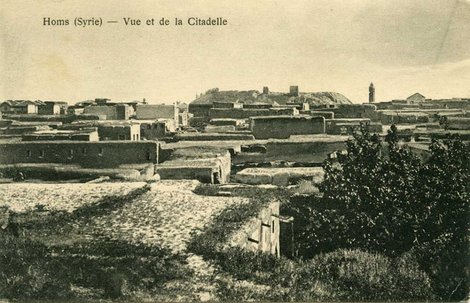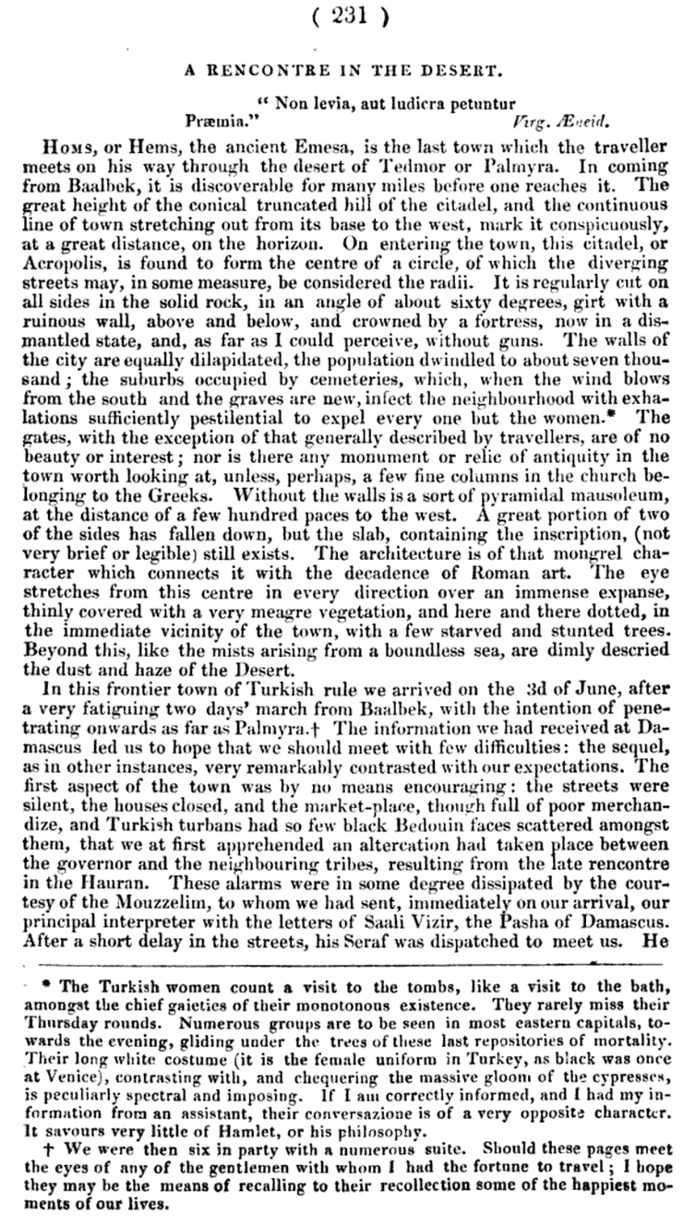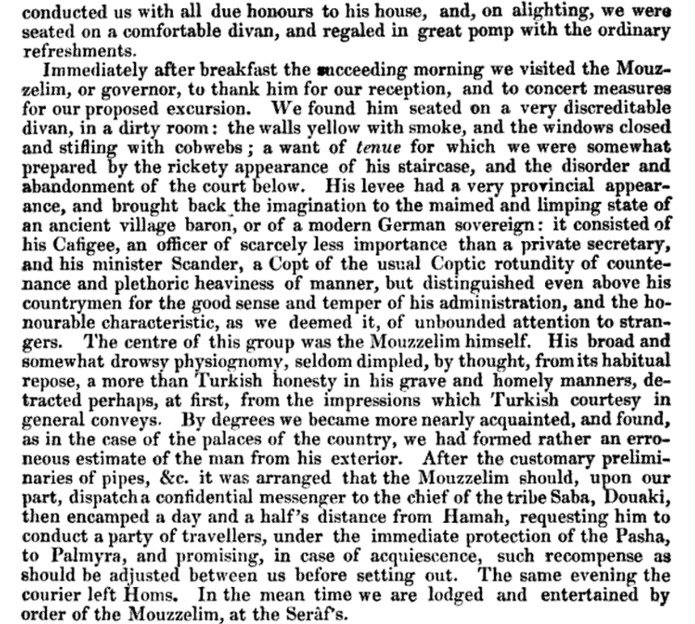|
Other Archaeological Sites / The Neolithic of the Levant (500 Page Book Online) Ancient Homs (Roman Emesa) in Syria
Selected Excerpt on Homs The Neolithic of the Levant by A.M.T. Moore at Oxford University (1978) Homs is strategically located at the fertile Orontes River between Damascus and Aleppo. It is very close to the coast and is not far from Hama to the north and Palmyra to the southeast. Homs is the only natural gateway from the Mediterranean coast to the interior (A). Excavations at the Citadel of Homs indicate that the earliest settlement at the site dates back to around 2300 BCE (B). It contained a great temple to the sun god El Gebal and was ruled by a line of priest-kings throughout the Roman Empire; two of its nobility rose to become emperor; Elagabalus (16 May 218 - 11 March 222) and Severus Alexande (11 March 222 - 18/19 March 235). The importance of the place arises from its command of the great north road from Egypt, Palestine and Damascus by the Orontes valley. Invading armies from the south have often been opposed near Homs, from the time of Rameses II, who had to fight the battle of Kadesh, to that of Ibrahim Pasha, who broke the first line of Ottoman defence in 1831 by his victory there (1). The First Syrian War (1831–1833) was a military conflict brought about by the Egyptian Muhammad Ali Pasha's demands to the Ottoman Empire for control of Greater Syria as reward for his assistance in Crete against Greece ... Ali sent his army into Syria under the command of his son Ibrahim Pasha. Near Homs the Egyptians under Ibrahim Pasha defeated an Ottoman force and occupied Homs on July 9 (SEE Invasion of Syria). Ancient Emesa, in the district of Apamea, was a very old Syrian city devoted to the worship of Baal the sun god, of whose great temple the emperor Heliogabalus (16 May 218 – 11 March 222) was originally a priest. As a centre of native [Arab] influences it was overawed by the Seleucid foundation of Apamea; but it opposed the Roman advance (1). After the conquest of the region by Alexander the Great and the subsequent wars between his generals, Apamea fell under the command of the former Macedonian general Seleucus from about 312 BC. From about 300 BC Apamea was fortified and established as a city by Seleucus who named it after his Bactrian wife Apama (SEE Apamea in Syria). Upon Pompey's incorporation of the Seleucid state of Syria into the Roman Empire in 64 BCE, the Emesani dynasty was confirmed in their rule as client kings of the Romans for aiding their troops in various wars (B). It was made a Roman colony with the Jus Italicum by Caracalla (4 April 188 – 8 April 217) (3). At Emesa Aurelian crushed in A.D. 272 the Syrian national movement led by Zenobia (1). Later Emesa became the capital of Phoenicia Libanesia (3) under the provincial reorganization of the Eastern Roman or Byzantine Empire by Theodosius II in the first half of the 5th century AD. The province included also the cities of Heliopolis -- Damascus and Palmyra (C). Emesa was taken in 636 by the Moslem leader Khalid ibn Walid and was renamed Homs. The city's large Christian element was eliminated during the rebellion of 855 when the churches were demolished and the Christians executed or deported (A). Under the Arabs it was one of the largest cities in Syria with walls and a strong citadel which stood on a hill occupying perhaps the site of the great sun temple. The ruins of this castle, blown up by Ibrahim Pasha, are still the most conspicuous feature of Homs and contain many remains of ancient buildings (1). At the end of the 11th century it fell into crusading hands but was recovered by the Moslems under Saladin in 1187. Its decay probably dates from the invasion of the Mongols (1260) who fought two important battles with the Egyptians (1281 and 1299) in its vicinity (1). Homs later (1516) passed into Ottoman hands where it remained --- except for a brief period of Egyptian control in the 1830s --- until the creation of Syria after World War I in 1922 (A). (2) Page 231-2 in The New Monthly Magazine (1828) (4) Pages 589-90 in A Handbook for Travellers in Syria and Palestine by Josias Leslie Porter and John Murray (Firm) (1868) ... We mount again for the last time; and as there is little to be seen and much to be feared, we spur our horses to a gallop and in 3 hours reach the gate of Hums. The plain is rich but it is swept by Arab cavaliers; the Orontes runs parallel to the road and only a mile or two to the westward. Hums -- Emesa is situated in the midst of a vast and fertile plain extending on the east to the horizon, but in that direction almost deserted. Bedawy robbers sweep it to the city walls. The river Orontes flows past about 1 mile to the west and is bordered by orchards and gardens. Hums is a clean and compact town; the houses built of basalt stone and most of the streets paved with the same material. It is encompassed by old walls barely sufficient to check a raid of Bedawin. There is no ancient building now remaining; the place has been too prosperous for that. In every direction however we see large hewn stones; fragments of columns of granite, basalt and limestone; and even Greek inscriptions here and there. On the south of the town rises the great mound on which the castle stood. It is about a 1/4 mile in circuit and above 100 feet high. It is encompassed by a broad fosse ; and the scarp was covered with sloping masonry, small portions of which remain. Round the summit ran a wall faced with limestone; but this too is nearly gone. The interior is covered with heaps of rubbish out of which, here and there, a large granite shaft peeps up. Emesa may be a very ancient city but we have no notice of it in history before the time of Strabo and Pliny (FootNote 10 in Page 439-40). It has already been stated that Emesa may probably be identical with the Biblical Zobah. It was early celebrated for a splendid temple of the Sun and for the gorgeous rites by which the “god of day” was worshipped. In A.D. 636 Emesa was captured by the Saracens (Arabs). During the following centuries it passed under the sway of the successive dynasties which ruled this section of the Muslem world. In 1099 the crusaders, after storming Antioch, marched up the valley of the Orontes and Hums, like other cities, opened its gates to them. Since that period the city has had its full share in the stirring incidents of Syrian history; but it has been more fortunate than most of its fellows; for while they lie ruined and deserted, here there is a large population and a prosperous trade.
(A) Homs --- © Copyright Homsonline.com
(B) Homs --- WikiPedia
(C) Geography of Phoenicia Canaan by Salim George Khalaf at © Phoenician Canaanite Encyclopedia
(1) 1911 Encyclopedia Britannica: A Dictionary of Arts, Sciences, Literature and General Information --- Volumes 13-14
(2) Page 231-2 in The New Monthly Magazine (1828)
(3) EMESA in the
Dictionary of Greek and Roman Geography by William Smith (1854) at the Perseus Digital Library at Tufts University
(4) A Handbook for Travellers in Syria and Palestine by Josias Leslie Porter and John Murray (Firm) (1868)
Ottoman Syria --- WikiPedia
|


